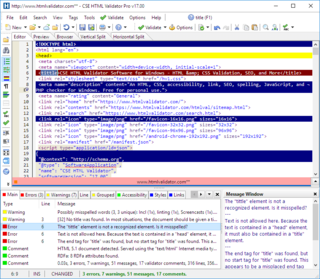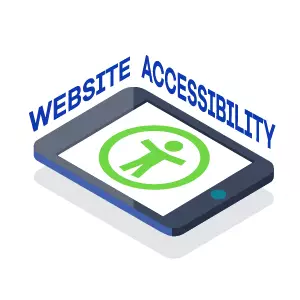History
BlindSurfer was founded in 2001 by Rudi Canters, a blind Internet pioneer. He was aided in his efforts by Blindenzorg Licht en Liefde. Thanks to financial support by Gelijke Kansen Vlaanderen, the project was consolidated in 2002. After Canters' death on 14 April 2003, the project and the renown of its label continued to grow. [2]
On 1 July 2006, BlindSurfer changed its name to AnySurfer. This was done in order to avoid reinforcing the stereotype that web accessibility only benefits the visually impaired, rather than people with disabilities as a whole. [3]
In December 2008, a second edition of the Web Content Accessibility Guidelines was published. AnySurfer took part in translating these updated guidelines into Dutch, and adapted their own checklist to conform to WCAG 2.0. [4]

Dutch(Nederlands ) is a West Germanic language spoken by around 23 million people as a first language and 5 million people as a second language, constituting the majority of people in the Netherlands and Belgium. It is the third most widely spoken Germanic language, after its close relatives English and German.
An HTML editor is a program for editing HTML, the markup of a web page. Although the HTML markup in a web page can be controlled with any text editor, specialized HTML editors can offer convenience and added functionality. For example, many HTML editors handle not only HTML, but also related technologies such as CSS, XML and JavaScript or ECMAScript. In some cases they also manage communication with remote web servers via FTP and WebDAV, and version control systems such as Subversion or Git. Many word processing, graphic design and page layout programs that are not dedicated to web design, such as Microsoft Word or Quark XPress, also have the ability to function as HTML editors.
The World Wide Web Consortium (W3C)'s Web Accessibility Initiative (WAI) is an effort to improve the accessibility of the World Wide Web for people with disabilities. People with disabilities may encounter difficulties when using computers generally, but also on the Web. Since people with disabilities often require non-standard devices and browsers, making websites more accessible also benefits a wide range of user agents and devices, including mobile devices, which have limited resources.

Accessibility is the design of products, devices, services, or environments for people with disabilities. The concept of accessible design and practice of accessible development ensures both "direct access" and "indirect access" meaning compatibility with a person's assistive technology.
A screen reader is a form of assistive technology (AT) which is essential to people who are blind, as well as useful to people who are visually impaired, illiterate, or have a learning disability. Screen readers are software applications that attempt to convey what people with normal eyesight see on a display to their users via non-visual means, like text-to-speech, sound icons, or a Braille device. They do this by applying a wide variety of techniques that include for example interacting with dedicated accessibility APIs, using various operating system features and employing hooking techniques.
Web usability is the ease of use of a website. Some broad goals of usability are the presentation of information and choices in a clear and concise way, a lack of ambiguity and the placement of important items in appropriate areas. Another important element of web usability is ensuring that the content works on various devices and browsers.
The alt attribute is the HTML attribute used in HTML and XHTML documents to specify alternative text that is to be rendered when the element to which it is applied cannot be rendered.
ATutor is an Open Source Web-based Learning Content Management System (LCMS).
PAS 78: Guide to good practice in commissioning accessible websites is a Publicly Available Specification published on March 8, 2006 by the British Standards Institution (BSI) in collaboration with the Disability Rights Commission (DRC). It provides guidance to organisations in how to go about commissioning an accessible website from a design agency. It describes what is expected from websites to comply with the UK Disability Discrimination Act 1995 (DDA), making websites accessible to and usable by disabled people
Within the field of human–computer interaction, game accessibility refers to the accessibility of video games. More broadly, game accessibility refers to the accessibility of all gaming products, including tabletop RPGs and board games. Video game accessibility is considered a sub-field of computer accessibility, which studies how software and computers can be made accessible to users with various types of impairments.
With an increasing number of people are interested in playing video games and with video games increasingly being used for other purposes than entertainment, such as education, rehabilitation or health, game accessibility has become an emerging field of research, especially as players with disabilities could benefit from the opportunities video games offer the most. A recent study estimates that 2% of the U.S. population is unable to play a game at all because of an impairment and 9% can play games but suffers from a reduced gaming experience. A study conducted by casual games studio PopCap games found that an estimated one in five casual video gamers have a physical, mental or developmental disability. As games are increasingly used as education tools, there may be a legal obligation to make them accessible, as Section 508 of the Rehabilitation Act mandates that schools and universities that rely on federal funding must make their electronic and information technologies accessible. As of 2015, the U.S. Federal Communications Commission (FCC) requires in game communication between players on consoles to be accessible to players with sensory disabilities
Actuate Corporation is a publicly traded reporting, analytics and customer communications software company based in San Mateo, California, part of the San Francisco Bay Area and Silicon Valley. The company is known for its creation of the open source Eclipse BIRT business data reporting project launched by the Eclipse Foundation in 2004. Actuate software helps businesses and OEMs worldwide serve their customers within the finance, government, manufacturing, telecommunications, and healthcare industries, among others.
User experience design is the process of enhancing user satisfaction with a product by improving the usability, accessibility, and pleasure provided in the interaction with the product. User experience design encompasses traditional human–computer interaction (HCI) design, and extends it by addressing all aspects of a product or service as perceived by users.
PDF/UA is the informal name for ISO 14289, the International Standard for accessible PDF technology. A technical specification intended for developers implementing PDF writing and processing software, PDF/UA provides definitive terms and requirements for accessibility in PDF documents and applications. For those equipped with appropriate software, conformance with PDF/UA ensures accessibility for people with disabilities who use assistive technology such as screen readers, screen magnifiers, joysticks and other technologies to navigate and read electronic content.
Accessible publishing is an approach to publishing and book design whereby books and other texts are made available in alternative formats designed to aid or replace the reading process. Alternative formats that have been developed to aid different people to read include varieties of larger fonts, specialised fonts for certain kinds of reading disabilities, Braille, e-books, and automated Audiobooks and DAISY digital talking books.

CSE HTML Validator, now renamed to CSS HTML Validator, is an HTML editor for Windows that assists web developers in creating syntactically correct and accessible HTML, XHTML, and CSS documents by locating errors, potential problems, and common mistakes. It is also able to check links, suggest improvements, alert developers to deprecated, obsolete, or proprietary tags, attributes, and CSS properties, and find issues that can affect search engine optimization.
Design for All in the context of information and communications technology (ICT) is the conscious and systematic effort to proactively apply principles, methods and tools to promote universal design in computer-related technologies, including Internet-based technologies, thus avoiding the need for a posteriori adaptations, or specialised design.
RoboBraille is a web and email service capable of converting documents into a range of accessible formats including Braille, mp3, e-books and Daisy. The service can furthermore be used to convert otherwise inaccessible documents such as scanned images and pdf files into more accessible formats. RoboBraille has been in operation since 2004 and currently serves thousands of user requests each month from users across the world. The service is available for free for strictly individual, non-commercial use. Institutional use by academic institutions is available through SensusAccess.
Kamiel Callewaert was a Belgian catholic priest and historian.





